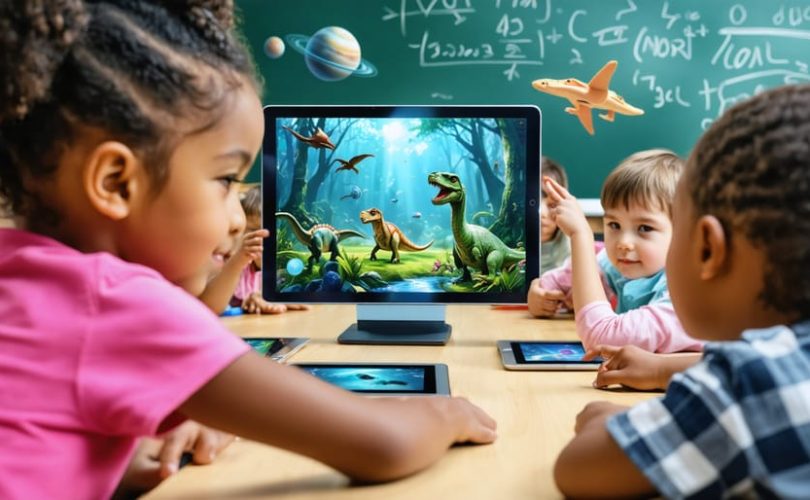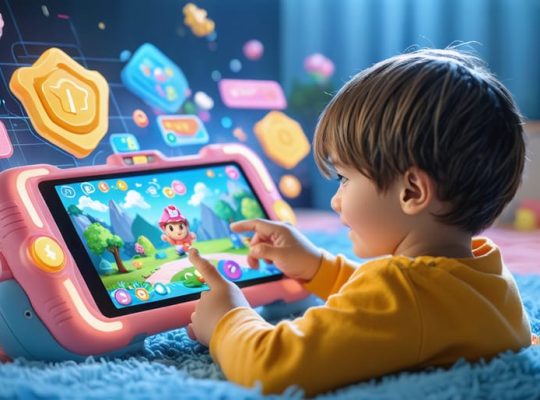Imagine stepping into a world where your child’s textbooks come alive, dinosaurs roam the classroom, and complex mathematical concepts transform into interactive 3D models right before their eyes. Augmented reality (AR) effects aren’t just changing how children learn – they’re revolutionizing the entire educational experience to transform your child’s education in ways we never thought possible.
As both a learning tool and a source of creative expression, AR technology bridges the gap between traditional teaching methods and the digital world our children inhabit. By overlaying virtual elements onto the real world through tablets, smartphones, or AR glasses, these interactive experiences make abstract concepts tangible and engagement effortless.
For parents and educators alike, understanding AR’s potential means recognizing it as more than just a technological novelty. It’s a powerful educational ally that can spark curiosity, enhance comprehension, and create immersive learning experiences that stick with children long after the lesson ends. Let’s explore how this groundbreaking technology is reshaping the educational landscape while keeping our children’s well-being at the forefront.
Understanding AR Effects in Educational Settings
Visual Overlays and 3D Models
Imagine holding up your phone or tablet and seeing colorful, animated objects appear right in front of you, as if they’re actually there in the room. This is how visual overlays work in augmented reality – they add digital elements to what we see in the real world through our device’s camera.
These overlays can range from simple 2D images, like fun stickers or educational labels, to complex 3D models that children can walk around and explore from different angles. For example, a student learning about the solar system might see a detailed 3D model of Earth floating above their desk, complete with rotating clouds and continents they can examine up close.
The technology uses special markers or spatial tracking to determine where to place these virtual objects in the real environment. When children move their device, the AR elements stay anchored in place, creating a convincing illusion that they’re actually there. This creates an interactive experience that feels natural and engaging, helping children better understand complex concepts through hands-on exploration.
Teachers and parents often notice how this visual approach helps children stay focused and excited about learning, especially for students who prefer visual or kinesthetic learning styles.
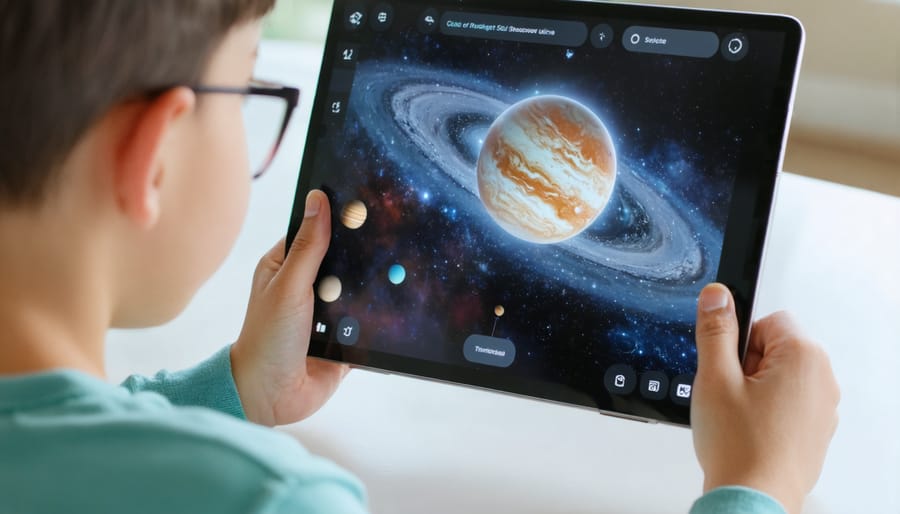
Interactive Elements and Animations
Interactive AR elements bring learning to life by responding to students’ natural movements and actions. When children reach out to touch a virtual butterfly, it might flutter away, teaching them about cause and effect. These dynamic responses create memorable learning experiences that help information stick.
Many AR activities include gesture recognition, allowing students to “grab” and manipulate virtual objects. For example, in science lessons, children can rotate 3D molecular structures or “dissect” virtual organisms with their hands. This hands-on interaction helps develop fine motor skills while making abstract concepts more concrete.
Voice commands and motion tracking add another layer of engagement. Students might speak simple commands to change colors or shapes, or move their bodies to navigate through virtual environments. These features are particularly helpful for kinesthetic learners who understand better through movement.
The most effective AR interactions provide immediate feedback. When students complete tasks correctly, they might see sparkles, hear encouraging sounds, or watch animations celebrate their success. This instant positive reinforcement helps maintain motivation and builds confidence in learning new concepts.
Benefits for Children’s Learning and Development
Enhanced Visual Learning and Memory Retention
When children engage with augmented reality (AR), they experience concepts in a way traditional learning methods can’t match. Picture a young student seeing a 3D model of the solar system floating above their desk, with planets rotating and moving in real-time. This visual and interactive experience creates stronger neural connections, making information more memorable and easier to recall.
Research shows that children retain up to 75% more information when learning through AR compared to conventional methods. This enhanced retention occurs because AR engages multiple senses simultaneously, creating a more immersive learning environment. When children can manipulate, rotate, and explore 3D models, they develop a deeper understanding of complex subjects.
AR visualization particularly benefits visual learners, who make up approximately 65% of the student population. For example, rather than just reading about cell structure in biology, students can examine a detailed 3D model of a cell, zooming in on different organelles and watching them function in real-time.
Parents and teachers report that children show increased enthusiasm and engagement when using AR learning tools. This heightened interest naturally leads to better focus and longer attention spans during lessons. The interactive nature of AR also encourages active participation rather than passive learning, helping children develop critical thinking skills as they explore and experiment with virtual content in their physical space.
Remember that AR should complement, not replace, traditional learning methods. The key is finding the right balance that works for your child’s unique learning style and needs.
Increased Engagement and Motivation
When children interact with AR effects during learning activities, they experience a remarkable transformation in their engagement levels. Instead of passively receiving information, they become active participants in their educational journey, creating more engaging learning experiences that stick with them long after the lesson ends.
Sarah Thompson, a third-grade teacher, shares how her students’ eyes light up when she introduces AR elements into science lessons: “When studying the solar system, instead of just looking at pictures in books, my students can now hold planets in their hands and watch them orbit. The excitement is contagious, and their questions become more thoughtful and curious.”
This increased motivation stems from several factors. First, AR effects tap into children’s natural curiosity and desire to explore. When abstract concepts become tangible through AR, children feel empowered to investigate and learn at their own pace. Second, the interactive nature of AR provides immediate feedback, helping children stay focused and engaged with the material.
Parents often notice their children voluntarily spending more time on educational activities when AR elements are involved. This natural enthusiasm for learning helps develop positive associations with education, potentially reducing academic stress and anxiety while building confidence in their abilities.
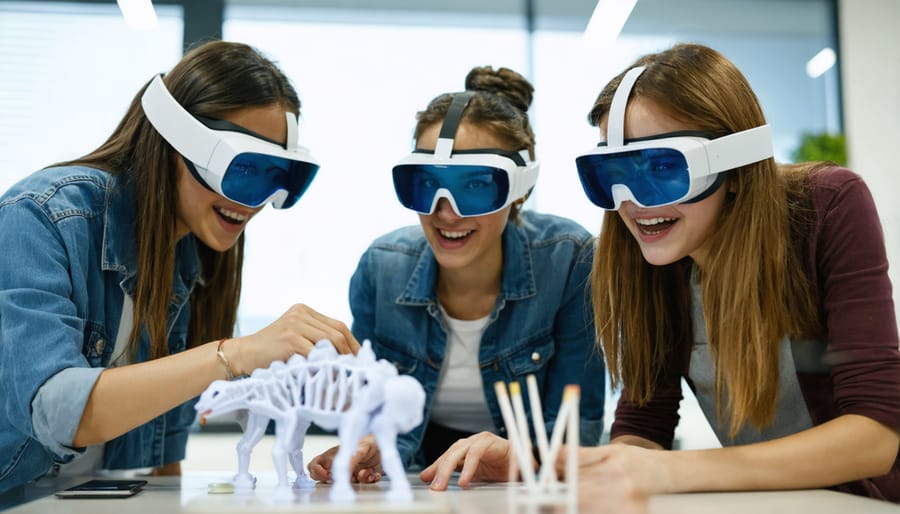
Supporting Mental Health Through AR Learning
Reducing Learning Anxiety
Augmented reality creates a safe haven for learning by removing many of the traditional pressures students face in conventional educational settings. When children interact with AR environments, they can make mistakes without fear of judgment or embarrassment, which is crucial for building confidence and maintaining engagement.
Consider a student practicing public speaking: Instead of facing a real audience, they can present to virtual characters, gradually building their confidence before tackling real-world situations. Similarly, students struggling with complex subjects like chemistry can experiment with virtual lab equipment without the anxiety of breaking expensive materials or making dangerous mistakes.
The interactive nature of AR allows learners to progress at their own pace, reducing the stress of keeping up with classmates. They can repeat exercises as many times as needed without feeling rushed or pressured. This self-paced approach is particularly beneficial for students with anxiety or learning differences.
As Sarah Miller, an educational psychologist, notes, “AR technology creates a buffer zone between the learner and the learning objective, allowing students to build skills and confidence in a psychologically safe environment before transitioning to real-world applications.”
Building Confidence Through Interactive Success
When children engage with AR environments, they experience success in controlled, supportive settings that gradually build their real-world confidence. As Dr. Sarah Chen, a child psychologist, explains, “Each small victory in an AR environment creates positive reinforcement that children can carry into their daily lives.”
Consider Emma, a 9-year-old who struggled with public speaking. Through an AR presentation practice app, she could see herself succeeding repeatedly in a virtual classroom setting. This practice translated into greater confidence during actual class presentations, as the positive experiences in the AR environment helped reshape her self-perception.
AR environments provide immediate feedback and celebration of achievements, creating a positive cycle of accomplishment. Children can practice challenging tasks without fear of judgment, allowing them to build competence at their own pace. This safe space for trial and error helps develop resilience and a growth mindset.
Parents and educators report that children who regularly engage with educational AR experiences show increased willingness to tackle new challenges in real life. The technology acts as a bridge, helping children transfer their virtual successes into tangible confidence in school, social situations, and everyday activities.
Practical Implementation Tips for Parents and Teachers
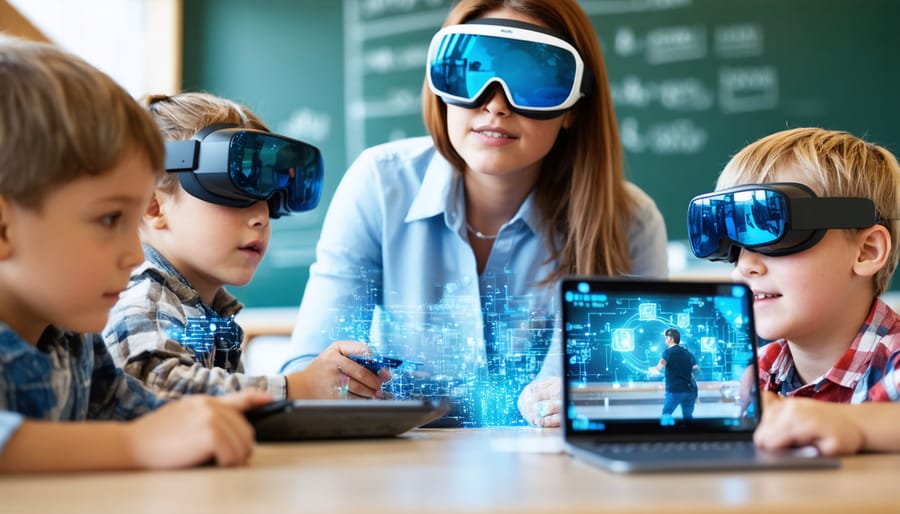
Getting Started with AR Learning Tools
Starting your journey with AR learning tools doesn’t have to be complicated or expensive. Many educators and parents are discovering that these interactive learning tools can be easily integrated into daily activities using devices you already own.
Begin with free educational AR apps available on smartphones or tablets. Many of these apps offer basic features perfect for beginners, such as 3D models of animals, planets, or historical artifacts that children can explore from different angles. Popular options include Google Expeditions for virtual field trips and Quiver for bringing coloring pages to life.
Sarah Martinez, a grade school teacher in Toronto, shares, “I started by using simple AR flashcards in my classroom. The children were amazed when they saw letters and numbers transform into animated characters. It made learning the alphabet so much more engaging!”
Consider these beginner-friendly steps:
– Download child-friendly AR apps that align with your learning objectives
– Start with short, 10-15 minute sessions to maintain engagement
– Choose topics that interest your child
– Create a designated space for AR activities
– Always supervise initial sessions to ensure proper use
Remember to gradually introduce these tools and maintain a balance with traditional learning methods. The goal is to enhance, not replace, existing educational approaches while making learning more enjoyable and memorable for children.
Maintaining Balance and Setting Boundaries
While AR technology offers exciting learning opportunities, it’s crucial to establish healthy boundaries for its use in educational settings. Just as we balance traditional educational games with other activities, AR experiences should be thoughtfully integrated into learning routines.
Start by setting clear time limits for AR activities, typically 20-30 minutes per session for younger children and up to 45 minutes for older students. Take regular breaks to prevent eye strain and maintain physical activity. Watch for signs that your child might be becoming overly dependent on AR, such as resistance to traditional learning methods or decreased interest in real-world interactions.
Create designated “AR-free zones” and times, such as during meals or before bedtime. This helps maintain a healthy balance between digital and traditional learning experiences. Encourage children to discuss their AR learning experiences, helping them process and integrate the knowledge they’ve gained through technology with real-world applications.
Remember that AR should enhance, not replace, traditional learning methods. Work with teachers to ensure AR activities align with educational goals and support, rather than distract from, core learning objectives. By establishing these boundaries early, we can help children benefit from AR technology while maintaining their overall well-being and social development.
As we look to the future of education, augmented reality effects present an exciting frontier that combines engagement with meaningful learning experiences. The potential to transform traditional lessons into interactive adventures makes AR a powerful tool for educators and parents alike. However, success lies in thoughtful implementation that prioritizes both educational outcomes and student well-being.
Research continues to demonstrate that when properly integrated, AR effects can enhance understanding, improve retention, and spark curiosity in ways traditional methods might not achieve. From bringing historical events to life to visualizing complex scientific concepts, the applications are limitless. Teachers report that students show increased motivation and participation when AR elements are incorporated into lessons.
Yet, it’s crucial to remember that technology should enhance, not replace, fundamental teaching principles. The most effective AR implementations maintain a balance between innovation and tried-and-true educational methods. Parents and educators should focus on creating structured environments where AR serves as a supplement to, rather than a substitute for, human interaction and guidance.
Moving forward, we encourage schools and families to explore AR possibilities while maintaining clear boundaries and guidelines. Start small, measure impact, and adjust accordingly. By taking this measured approach, we can harness the transformative power of AR effects while ensuring our children’s educational experience remains grounded, meaningful, and healthy.
Remember, the goal isn’t to embrace technology for its own sake, but to use it thoughtfully to create better learning outcomes for our children.

